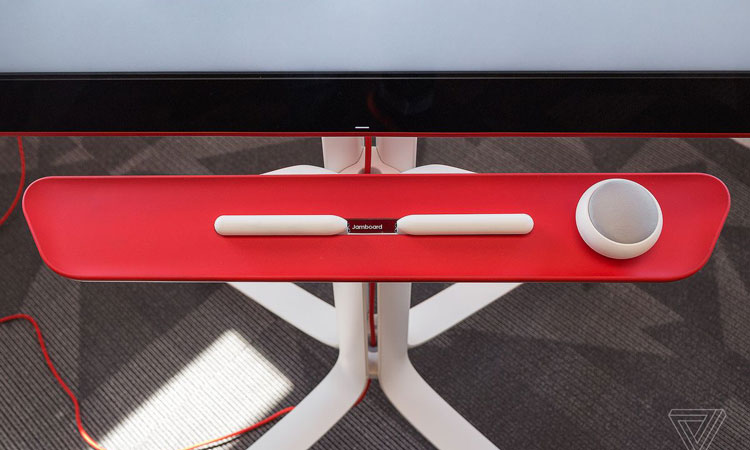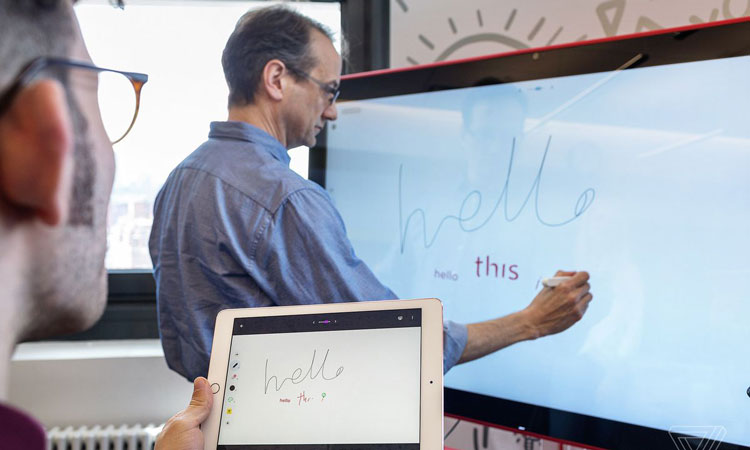Life in a modern day office is quite odd when you think about it; there a number of people all sat in the same room often not interacting, yet constantly communicating through chats and emails.
Some colleagues may only be known to know as digital avatars and now some meetings are filled with more faces on a screen than actually there in person.
Google has been improving this space for years with tools like Docs and Drive, and it’s now taking a step into the physical world with an alternative to Microsoft’s digital whiteboard, the Surface Hub.
Google’s version is called the Jamboard. It’s a digital, internet-connected ‘whiteboard’ that looks like a blown-up children’s tablet. The product will cost you a bit, nearly $5,000 (though $4,000 less than Microsoft’s Surface Hub), and it only includes relatively basic functionality.
But the Jamboard does have a fun feel to it, a useful way to work with co-workers who can’t be there in person.
The basics of the Jamboard are just like a whiteboard. You walk up to it, pick up a pen, and start writing. But that’s where the similarities stop. The Jamboard is really a 55” 4K screen. And it isn’t just for one person to work on – everything written on one Jamboard can be mirrored across dozens of other Jamboards, as well as computer and tablet screens. The people on the other side of those devices can work on the very same board, too.
The product is simple to get started with. You just start writing, and your text or scribbles appear for everyone else. There are tools to help you draw shapes and sketch in different sizes and colors, and there is some excellent handwriting recognition that can even make sense borderline illegible markings.
However, the board’s handwriting recognition was made by another group inside Google.
Brainstorming on a whiteboard really doesn’t work if you have remote colleagues, but it’s pretty easy to imagine that, with a couple of Jamboards, employees in multiple offices could start handwriting their own thoughts on the board as ideas get thrown around. And remote co-workers would be able to view the presentation on the web or add their own thoughts through the Jamboard tablet app.
The Jamboard also has some much more obviously digital features, like the ability to pull in photos and website screenshots, to add emoji and other stickers, and to take pictures with a built-in webcam. (It can also be used for video chatting… and selfies.) These features are pretty simple right now, for better or worse. It quickly becomes apparent that the Jamboard isn’t going to be used for anything close to the final, presentable work you get in something like Docs or PowerPoint – it’s good at one thing: creating what are essentially big collages.
Google is already considering ways to update the Jamboard to make it integrate with other tools that workplaces rely on. This could mean the entire Jamboard switching over to a professional app, like Trello, or it could mean new tools and widgets inside the existing Jamboard experience.
“We’ve been hearing of partners who are interested to integrate with the Jamboard app itself, so being part of delivering a component to what would be brainstorming,” said TJ Varghese, who led creation of the Jamboard.
The Jamboard’s simplicity is also what sets it apart from Microsoft’s direct challenger: the Surface Hub – its own giant, collaborative display.
Jonathan Rochelle, director of product management at Google and the co-founder of Docs, commented that he can see Google’s product standing out from Microsoft’s, because of the fact that the Jamboard isn’t meant to be a computer.
Microsoft’s product is much more expensive, with a 55” 1080p model selling for $8,999 and an 84” 4K model selling for $21,999. The big difference is that Microsoft’s product is essentially just a giant Windows all-in-one PC capable of running apps and doing the many complicated things that Windows PCs can do, whereas Google’s product only runs a single app – it’d be like buying a laptop that only runs Google Docs.
“Jamboard is not meant be a computer on your wall. It is definitely a collaborative whiteboard, and Surface Hub, I think, is more angled at, ‘this is a Windows device on your wall so you can do other things on it,” Rochelle said. “If you have a Jamboard on the wall and a Surface Hub next to it, people would be able to go up to the Jamboard and use it right away, and I would challenge that that’s not true with a computer on the wall.”
There’s a good argument to be made that the Jamboard’s laser-focus is a big limitation, but those limitations are part of what makes it so simple and immediately easy to use. Especially when it comes to video conferencing, more complexity would be useful.
Although though there’s a built-in webcam, video chatting on the Jamboard is an experience. When it’s brought into a video conference, the Jamboard has to pick between one of two modes: broadcasting video from its webcam, or broadcasting what’s on the board. It can’t do both at once, which means you can’t see a person and what they’re writing at the same time. Varghese says this is because Google thought it would be odd to show people right up against the board, with the camera shooting the tops of everyone’s heads. So instead, you’re supposed to set up another camera elsewhere in the room and use that to actually see each other.
Being able to see your co-worker writing on the board could make the experience feel more personal and collaborative. And, it could provide important conversational cues, like whether your colleague is about to write something or is looking back to you for input.
The camera’s video quality wasn’t as impressive as it could be, and the audio is reported to sometime sound a bit quiet and distant – though Varghese said this was a bug that would be fixed before launch.
The Jamboard could be seen as a missed opportunity to chip away at the miserable experience that is video conferencing. It’s not clear if Google has plans to tackle that later – it might make sense, given that it already has Hangouts – but Varghese indicated that Google has bigger plans for office hardware than just the Jamboard.
“We are investing in spending a lot of time in communications and in meeting spaces and in collaboration,” said Varghese. “So I think it’s safe to say that, yes, this space will see a lot of activity.”
Varghese said that video conferencing and working with documents are two areas that Google is interested in exploring. He also said there’s more room to bring Google’s cloud intelligence down to office products.
Everyone outside of Google who discussed the Jamboard immediately asked about whether the product would work for education, too. And while Rochelle indicates that Google would be happy to sell Jamboards to schools, he said it isn’t really designed for them.
“The problem we have is, we don’t think it’s a presentation device,” Rochelle said. “It’s not something you’d put at the front of a classroom and have a teacher point and click through the web. That’s how a lot of the current education projects are aimed at schools, that’s not the intention of this product.”
On top of that, the Jamboard’s price is likely prohibitive. Google’s success in the education market thus far has come from its focus on promoting super-cheap Chromebooks, which usually cost under $300. The Jamboard costs almost 20 times as much for a single unit and a year of service.
Sales of the Jamboard have begun in the US, with the product selling for $4,999, plus an additional $600-per-year service fee for every single unit. If you want a rolling stand to put one on, instead of just a wall mount, you’re looking at another $1,349.
In the future, if the Jamboard could replace a video conferencing screen, too, then maybe more people would find it appealing.



Comments are closed, but trackbacks and pingbacks are open.